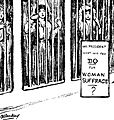Nineteenth Amendment to the United States Constitution facts for kids
The Nineteenth Amendment (also known as Amendment XIX) is an important part of the U.S. Constitution. It was officially added on August 18, 1920. This amendment gave American women the right to vote.
This change ended a long fight for women's voting rights in the United States. This fight, known as the women's suffrage movement, started in the mid-1800s. Before this, it was often believed that a married woman did not have her own separate legal identity from her husband. This meant her husband controlled her property and legal standing. The women's suffrage movement challenged this old idea.
The Nineteenth Amendment also changed an earlier decision by the U.S. Supreme Court in a case called Minor v. Happersett. In that case, the Court had said that even though women were citizens, the right to vote (which the Fourteenth Amendment gave to all citizens) did not apply to them. The Nineteenth Amendment fixed this.
The idea for this amendment was first brought to Congress in 1878 by Senator Aaron A. Sargent. For the next 40 years, the bill was introduced every year but did not pass. Finally, in 1919, Congress approved the amendment. Then, it was sent to the states to be approved by them. A year later, Tennessee became the last state needed to approve the amendment, making it a part of the Constitution.
Contents
What the Nineteenth Amendment Says
The Nineteenth Amendment is very clear about who can vote. It states:
The right of citizens of the United States to vote shall not be denied or limited by the United States or by any State because of a person's sex.
Congress will have the power to make laws to put this article into effect.
This means that neither the U.S. government nor any state government can stop someone from voting just because they are a woman.
Why the Amendment Was Needed
In the early days of Colonial America, women had specific gender roles. These roles were often learned from their mothers. A young woman was legally under her father's control. When she got married, she became a feme covert, which is a French term meaning "a married woman."
When a woman married, her property and legal rights were given to her husband. This old custom was meant to "protect" women from things like politics. But it also stopped women from having many professional jobs, getting a higher education, voting, serving on juries, or speaking in court. Single women usually only had jobs like teaching and nursing.
The women's suffrage movement started nationally in 1848. This happened at a meeting in Seneca Falls, New York. This meeting was organized by abolitionists Elizabeth Cady Stanton and Lucretia Mott. At this meeting, they demanded that women should have the right to vote.
Later, Susan B. Anthony and other activists joined Mott and Stanton. They formed groups that worked hard for women's voting rights. Many of these early leaders never lived to see the Nineteenth Amendment passed, which happened about 70 years later.
How the Amendment Was Confirmed
When the Nineteenth Amendment became law, it said that the right to vote could not be taken away because of a person's sex. However, some people still tried to stop women from voting. The Supreme Court case of Leser v. Garnett in 1922 helped make sure women could truly vote.
In this case, some people challenged the Nineteenth Amendment. They said it was against the Constitution for a few reasons:
- First, they argued that the amendment was not valid because it added more voters without the state of Maryland's permission.
- Second, they said that some states that approved the amendment had state constitutions that did not allow women to vote. So, they argued, these states' legislatures (law-making bodies) did not have the right to approve the amendment.
- Third, they claimed that the last two states to approve the amendment, Tennessee and West Virginia, did not follow their own rules for approving it.
The Court listened to all these arguments. In a decision where all the judges agreed, the Court rejected every argument:
- The first argument was not valid because the Nineteenth Amendment's wording was very similar to the Fifteenth Amendment. Both amendments were approved in the same way, so if one was valid, the other had to be too.
- The second argument was rejected because when states approve a federal amendment, they are doing a federal job, not just following their state rules.
- The third argument was considered a "moot point." This means it didn't matter in the end because two other states (Connecticut and Vermont) approved the amendment after Tennessee and West Virginia, and they followed all their rules. This would have been enough to approve the amendment anyway. The Court also pointed out that the Secretaries of State in Tennessee and West Virginia officially accepted their states' approval, making them valid.
So, the Nineteenth Amendment gave women the right to vote. The Leser v. Garnett case made sure that this right could be used everywhere, even in states where the state's own constitution had not allowed it before.
Images for kids
-
The Nineteenth Amendment document in the National Archives.
-
Elizabeth Cady Stanton (sitting) with Susan B. Anthony.
-
Elizabeth Cady Stanton speaking before the Senate Committee on Privileges and Elections in 1878.
-
Suffragist and civil rights activist Mary Church Terrell.
-
Carrie Chapman Catt, who led the National American Woman Suffrage Association, helped pass the Nineteenth Amendment.
-
The "Silent Sentinels" protesting in front of the White House in 1917.
-
A political cartoon by Nina E. Allender about President Wilson, published in The Suffragist in 1917.
See also
 In Spanish: Decimonovena Enmienda a la Constitución de los Estados Unidos para niños
In Spanish: Decimonovena Enmienda a la Constitución de los Estados Unidos para niños














